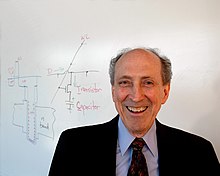Robert H. Dennard
Robert H. Dennard | |
|---|---|
 | |
| Born | September 5, 1932 Terrell, Texas, U.S. |
| Died | April 23, 2024 (aged 91) |
| Known for | Inventing DRAM, Dennard scaling |
| Awards | Harvey Prize (1990) IEEE Edison Medal (2001) IEEE Medal of Honor (2009) Kyoto Prize (2013) Robert N. Noyce Award (2019) |
| Scientific career | |
| Thesis | Behavior of the ferroresonant series circuit containing a square-loop reactor (1958) |
| Doctoral advisor | Leo A. Finzi |
Robert Heath Dennard (September 5, 1932 – April 23, 2024) was an American electrical engineer and inventor.[1]
Biography
[edit]Dennard was born in Terrell, Texas. He received his B.S. and M.S. degrees in electrical engineering from Southern Methodist University, Dallas, in 1954 and 1956, respectively. He earned a Ph.D. from Carnegie Institute of Technology in Pittsburgh, Pennsylvania, in 1958. His professional career was spent as a researcher for International Business Machines.[1]
Single Transistor DRAM
At the time of the invention, Dennard and his colleagues were fixated on a bulky, costly memory system that used a series of six transistors to store just 1 bit of data.[2]
One night while lying on the couch and pondering a presentation given by his peers earlier in the day, he had a notion: What if he could store a bit of information in a single transistor? The insight was the catalyst for DRAM — Dennard’s most important innovation.[3]
In 1966 he invented the one transistor memory cell consisting of a transistor and a capacitor for which a patent was issued in 1968.[4] It became the basis for today's dynamic random-access memory (DRAM) and almost all other memory types such as SRAM and FLASH memory. DRAM was instrumental in changing the world of computing once and for all through faster and higher capacity memory access.[1] Today, DRAM is used pervasively across many devices from servers to personal computers to mobile devices.
Dennard Scaling
Dennard was also among the first to recognize the tremendous potential of downsizing MOSFETs. The scaling theory he and his colleagues formulated in 1974 postulated that MOSFETs continue to function as voltage-controlled switches while all key figures of merit such as layout density, operating speed, and energy efficiency improve – provided geometric dimensions, voltages, and doping concentrations are consistently scaled to maintain the same electric field. This property underlies the achievement of Moore's Law and the evolution of microelectronics over the last few decades.[1]As of 2024, the DRAM market is estimated to be over $100 Billion.[5]
Awards and Recognition
In 1984, Dennard was elected a member of the National Academy of Engineering for pioneering work in FET technology, including invention of the one transistor dynamic RAM and contributions to scaling theory.
Besides his technical accomplishments, Dennard, he was involved in other creative fields. Throughout his retirement, Dennard continued to fuel his creativity through choral singing and Scottish dancing.[3]
Dennard died on April 23, 2024, at the age of 91.[6][1]
Awards and honors
[edit]- Robert N. Noyce Award (2019)[7]
- Kyoto Prize (2013)[8]
- Carnegie Mellon University Honorary Doctor of Science and Technology (2010)
- IEEE Medal of Honor (2009)
- IEEE Edison Medal (2001)[9]
- Benjamin Franklin Medal in Electrical Engineering from The Franklin Institute (2007)[10]
- U.S. National Academy of Engineering (NAE) Charles Stark Draper Prize (2009)
- elected member of the American Philosophical Society (1997)[11]
- Southern Methodist University Honorary Doctor of Science (1997)
- Harvey Prize from Technion Institute in Haifa / Israel (1990)
- Industrial Research Institute (IRI) Achievement Award (1989)[12]
- U.S. National Medal of Technology (1988)[13][14][3]
- National Academy of Engineering Member (1984)
- IEEE Cledo Brunetti Award (1982)
- appointed IBM Fellow (1979)
See also
[edit]References
[edit]- ^ a b c d e Lohr, Steve (May 16, 2024). "Robert Dennard, IBM Inventor Whose Chip Changed Computing, Dies at 91". The New York Times. ISSN 0362-4331. Retrieved May 17, 2024.
- ^ "Dynamic random-access memory (DRAM)". IBM. Retrieved August 19, 2024.
- ^ a b c "The inventor of DRAM laid the foundation for modern computing and received the US National Medal of Technology". IBM. Retrieved August 19, 2024.
- ^ US3387286A, Dennard, Robert H., "Field-effect transistor memory", issued 1968-06-04
- ^ "DRAM Market Size, Share, Trends, Growth | Forecast [2032]". Fortune Business Insights. Retrieved August 19, 2024.
- ^ "Robert Dennard Obituary – Death Notice and Service Information". Legacy.com. May 2, 2024.
- ^ Russell, John (November 12, 2019). "SIA Recognizes Robert Dennard with 2019 Noyce Award". HPC Wire. Retrieved July 14, 2020.
- ^ Taft, Darryl K. (June 24, 2013). "IBM Researcher Wins Kyoto Prize for DRAM Invention". eWeek. Archived from the original on October 26, 2013. Retrieved June 24, 2013.
- ^ "Edison Medal", Awards, IEEE, 2001[dead link].
- ^ Benjamin Franklin Medal in Electrical Engineering, Franklin Institute, 2007, archived from the original on October 12, 2007.
- ^ "APS Member History". search.amphilsoc.org. Retrieved December 10, 2021.
- ^ "Dennard, Robert H", People, Computer History Museum, retrieved February 9, 2012.
- ^ National Medal of Technology recipients, 1988, archived from the original on August 12, 2006.
- ^ "Robert H. Dennard". National Science and Technology Medals Foundation. Retrieved August 19, 2024.
External links
[edit]- "Robert Dennard", Inventor of the Week (Archive), MIT, archived from the original on April 15, 2003.
- "Robert H Dennard", Legacies (Bio), IEEE, August 10, 2017, archived from the original on November 21, 2014, retrieved July 25, 2011.
- 1932 births
- 2024 deaths
- 20th-century American inventors
- American electrical engineers
- Carnegie Mellon University College of Engineering alumni
- People from Terrell, Texas
- National Medal of Technology recipients
- IEEE Edison Medal recipients
- Draper Prize winners
- IBM employees
- IBM Fellows
- Members of the United States National Academy of Engineering
- IEEE Medal of Honor recipients
- Members of the American Philosophical Society
- Kyoto laureates in Advanced Technology
- Benjamin Franklin Medal (Franklin Institute) laureates
